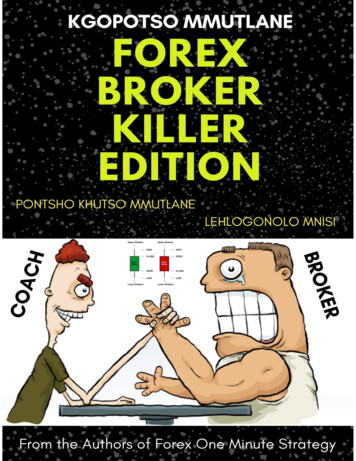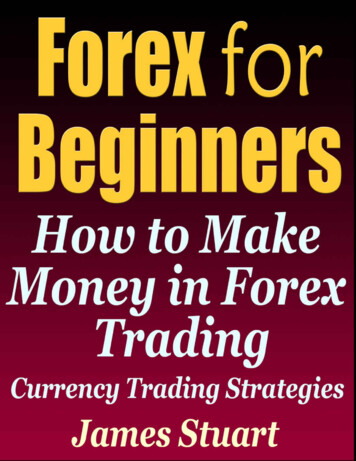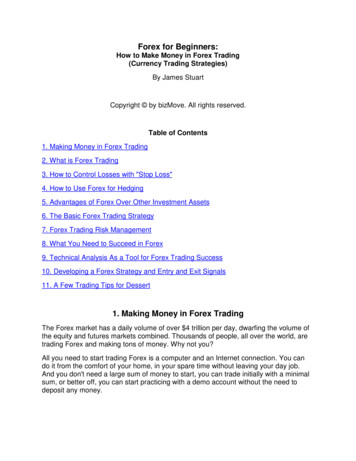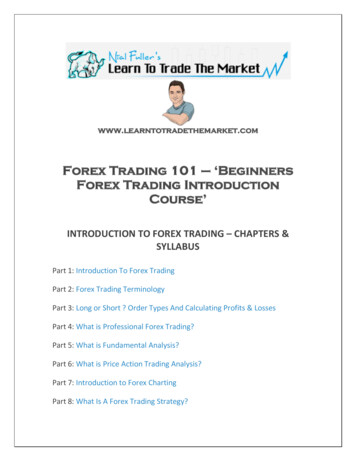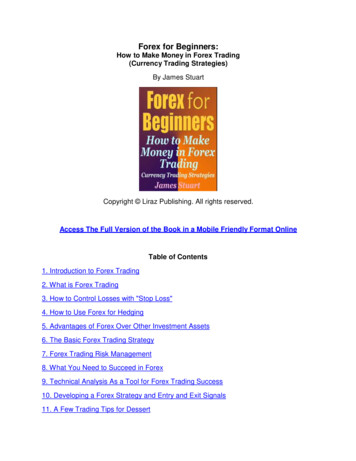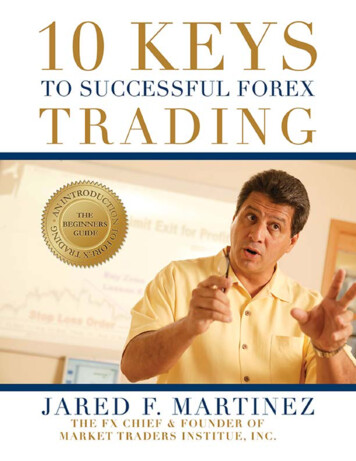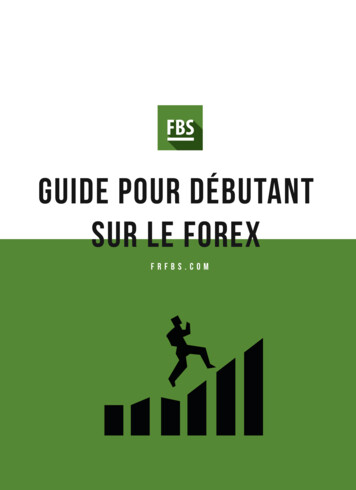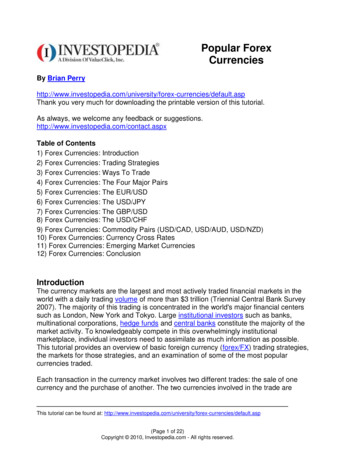
Transcription
Popular ForexCurrenciesBy Brian currencies/default.aspThank you very much for downloading the printable version of this tutorial.As always, we welcome any feedback or pxTable of Contents1) Forex Currencies: Introduction2) Forex Currencies: Trading Strategies3) Forex Currencies: Ways To Trade4) Forex Currencies: The Four Major Pairs5) Forex Currencies: The EUR/USD6) Forex Currencies: The USD/JPY7) Forex Currencies: The GBP/USD8) Forex Currencies: The USD/CHF9) Forex Currencies: Commodity Pairs (USD/CAD, USD/AUD, USD/NZD)10) Forex Currencies: Currency Cross Rates11) Forex Currencies: Emerging Market Currencies12) Forex Currencies: ConclusionIntroductionThe currency markets are the largest and most actively traded financial markets in theworld with a daily trading volume of more than 3 trillion (Triennial Central Bank Survey2007). The majority of this trading is concentrated in the world's major financial centerssuch as London, New York and Tokyo. Large institutional investors such as banks,multinational corporations, hedge funds and central banks constitute the majority of themarket activity. To knowledgeably compete in this overwhelmingly institutionalmarketplace, individual investors need to assimilate as much information as possible.This tutorial provides an overview of basic foreign currency (forex/FX) trading strategies,the markets for those strategies, and an examination of some of the most popularcurrencies traded.Each transaction in the currency market involves two different trades: the sale of onecurrency and the purchase of another. The two currencies involved in the trade areThis tutorial can be found at: ncies/default.asp(Page 1 of 22)Copyright 2010, Investopedia.com - All rights reserved.
known as a pair. While it is possible to swap virtually any currency for another, themajority of trading occurs among a handful of popular currency pairs.MarketCurrency UD2.1%CAD1.6%Figure 1: The most heavily tradedcurrencies and their market shareSource: BIS Triennial Survey, 2004The chart shows the most heavily traded currencies and their market share. Totalmarket share adds up to 200% because each transaction involves two currencies (ECB:BIS Triennial Survey 2004).As the world's reserve currency, the U.S. dollar is the most actively traded currency, andpairs involving the dollar make up the majority of transactions. Therefore, this tutorialexamines the trading relationships between the U.S. dollar and several of its chiefcounterparts, including the euro, the Japanese yen, the British pound, and the Swissfranc. The tutorial also examines other popular trading pairs involving the U.S. dollarand the commodity currencies – those of Canada, Australia, and New Zealand.Although the average trader will likely participate only in trades involving the U.S. dollar,this tutorial includes a discussion of cross rate pairs – pairs of significant internationalcurrencies that are not the U.S. dollar. Additionally, because emerging markets form animportant part of the global financial system, this tutorial also examines the uniquechallenges facing individuals interested in trading emerging market currencies.(Formore information, read The Foreign Exchange Interbank Market.)Before the discussion of popular trading pairs, a brief analysis describes some of theinstruments, concepts and strategies that should be familiar to investors trading in thecurrency markets.This tutorial can be found at: ncies/default.asp(Page 2 of 22)Copyright 2010, Investopedia.com - All rights reserved.
Trading StrategiesFor beginning investors, there are a variety of currency trading strategies available.However, most strategies fall into two broad categories: hedging and speculating.HedgingWhen companies sell goods or services in foreign countries, they are usually paid in thecurrency of the country in which the sale occurs. But currencies can fluctuate, causingthe sale to be valued (in the home country) at less than hoped for or expected. To avoidpossible loss from fluctuating currencies, companies can hedge, or protect themselves,by trading currency pairs. Protection against the possibility of adverse currencymovement helps companies focus on generating revenues.Sometimes, traders in the international financial market hedge their foreign currencyexposures to gain as much as possible from their investments. A mutual fund managerwho wants to hold Japanese stocks, for example, may not want to be exposed tomovements in the Japanese yen. As the manager hedges against those movements,she secures "pure" exposure to Japanese stock price movements – exposureunhampered by fluctuations. These hedging activities constitute a sizable portion ofdaily currency turnover. As such, they are important for investors to understand. (Tolearn more, read A Beginner's Guide To Hedging and Using Interest Rate Parity ToTrade Forex.)SpeculatingThe activities of most investors will fall under the broad category of speculation, whichinvolves buying or selling a financial asset, usually in the face of higher-than-ordinaryrisk, in order to take advantage of an expected move. Speculators in the currencymarket wager that, in the future, the value of a currency will move higher or lowerrelative to another currency. In addition to individual investors, speculators in thecurrency market can include hedge funds, commercial banks, pension funds orinvestment banks. Currencies are traded in pairs, so in any given transaction, a trader iswagering that one currency will rise while the value of the second will fall. Most currencytrading occurs among a handful of very liquid and active pairs. Investors interested intrading these pairs need to formulate an understanding of the characteristics of thecurrencies involved and the factors that cause the movements between the currenciesthat constitute these pairs. Popular pairs will be covered in much greater detail later inthis tutorial. (For more insight, check out Using Currency Correlations To YourAdvantage and Finding Profit In Pairs.)Other Trading StrategiesIn addition to trades that focus upon the relative value between two currencies, thereare also other popular types of currency trades. In arbitrage trades, an investorsimultaneously buys and sells the same security (perhaps a currency) at slightlydifferent prices, hoping to make a small, risk-free profit. While this is obviously anThis tutorial can be found at: ncies/default.asp(Page 3 of 22)Copyright 2010, Investopedia.com - All rights reserved.
attractive proposition, arbitrage opportunities are very rare in efficient markets becausethere are many other investors also seeking to exploit these opportunities. Therefore,any arbitrage possibilities that do exist disappear quickly. Investors interested inarbitrage opportunities need to closely monitor market developments and actimmediately when opportunities appear. When opportunities are available, the pricedifferential is usually quite small. To generate a substantial profit, investors need totrade in sizes large enough to magnify the small price differentials. (To learn more aboutthis strategy, read Trading The Odds With Arbitrage and Arbitrage Squeezes ProfitFrom Market Inefficiency.)Another popular category of currency trade is the carry trade, which involves selling thecurrency of a country with very low interest rates and investing the proceeds in thecurrency of a country with high interest rates. In this category, the trader generates aprofit as long as the relationship between the two currencies is relatively stable. Thecarry trade is usually practiced by large, sophisticated investors (such as hedge funds)and is extremely popular during times of low market volatility. During high volatility, largefluctuations in the value of currencies and other financial assets can quickly overwhelmthe traditionally slow-and-steady profits found in the carry trade. Therefore, investorstend to shun the carry trade when market volatility rises. (Learn more about this tradein Currency Carry Trades Deliver and Profiting From Carry Trade Candidates.)Ways To TradeInvestors need to select not only a trading strategy and a currency pair but also amarket in which to trade. There are several markets available to currency traders,including the forex market, derivatives markets and exchange-traded funds.Trading ForexThe majority of currency trading takes place in the forex spot market. In the forex spotmarket, large banks and other financial institutions trade currencies among themselveseither for immediate delivery (spot market) or for settlement at a later date (forwardmarket.) Trades in the forex market occur over the counter, and the minimum size oftrades is very large. For these reasons, it has traditionally been impractical for individualinvestors to trade in the forex market.However, over the past several years, a new retail forex market has developed. Thismarket allows individual investors and small institutions to trade in the forex market insmaller volumes than those previously available. For the more heavily tradedcurrencies, bid-ask spreads are relatively narrow, and market liquidity can be excellent.Many currency brokerage firms will also allow investors high levels of leverage – insome cases 400:1 or higher. While the use of leverage can magnify investors' potentialreturns, it is important to remember that leverage also magnifies potential losses.Investors should carefully consider their risk tolerance before employing leverage. (Formore information concerning leverage in the forex markets, see Forex Leverage: AThis tutorial can be found at: ncies/default.asp(Page 4 of 22)Copyright 2010, Investopedia.com - All rights reserved.
Double-Edged Sword. For another viewpoint on leverage, also see Leverage's "DoubleEdged Sword" Need Not Cut Deep.)Because currency brokerage firms vary greatly in their resources, minimum accountsizes, available leverage and execution ability, investors should carefully evaluateseveral brokerage firms before opening a currency trading account. (To learn more, seeForex Basics: Setting Up An Account.)Derivatives MarketsDerivatives include futures, options and exotic, customizable derivative contracts. Whilethe more exotic derivatives are generally designed for institutional investors, individualinvestors often use futures and options.The most popular currency pairs have both futures contracts (that track the currencypair's movements) and options on those futures contracts. Individual investors can buyor sell the futures or the options to speculate on the direction of the currency pair. Thesefutures and options usually feature reasonably good liquidity, transparent pricing andmoderate capital requirements. For these reasons, futures or options are a viablechoice for individual investors interested in the currency market. (Learn more about thismethod of forex trading in Getting Started In Foreign Exchange Futures.)When using futures or options, it is very important to remain aware of the risks involvedin using these financial instruments. While large gains are possible, the majority ofinvestors using these securities eventually lose money. Additionally, futures contractscarry the possibility of potentially unlimited losses. Before employing a futures tradingstrategy, investors should carefully consider their risk tolerance and thoroughlyunderstand potentially adverse price movements.Exchange Traded Funds (ETFs)A relatively new addition to the currency trading universe is the exchange-traded fund(ETF). ETFs have been popular vehicles for tracking stock or bond indexes for manyyears, but ETFs that track currency movements are relatively new. A currency ETF canbe bought and sold just like any other stock. Investors who believe the currency is aboutto rise in price should buy the ETF; investors who believe the currency will decline invalue should sell the ETF. One advantage of ETFs is that they may be more familiar tothe average investor than the forex or derivatives markets. ETFs also carry strictermargin requirements, so they may appeal to more risk-averse investors. (Checkout Profit From Forex With Currency ETFs and Currency ETFs Simplify Forex Trades.)Indirect Currency ExposureForex investors should know that purchasing foreign securities exposes them to the riskof potential currency movements. Investors with no intention of directly trading foreigncurrencies, however, can benefit from a better understanding of the links betweenThis tutorial can be found at: ncies/default.asp(Page 5 of 22)Copyright 2010, Investopedia.com - All rights reserved.
international currencies – because these currency movements can ultimately affect thevalue of other financial assets.The Four Major PairsIn forex trading, four major currency pairs are the most popular: EUR/USD: The euro and the U.S. dollarUSD/JPY: The U.S. dollar and the Japanese yenGBP/USD: The British pound sterling and the U.S. dollarUSD/CHF: The U.S. dollar and the Swiss francThese pairs are discussed in the following segments, along with the role of eachcurrency in the economy of its country (and the world) and the factors affecting thecurrency's movement. (Learn more about how pairs are traded in Finding Profit InPairs.)The EUR/USDThe United States and the European Union are the two largest economic entities in theworld. The U.S. dollar is the world's most heavily traded and most widely held currency.The currency of the European Union, known as the euro, is the world's second mostpopular currency. Because it is made up of the two most popular currencies in theworld, the EUR/USD is the most actively traded currency pair.The United States EconomyThe United States is the largest national economy in the world, with a gross domesticproduct (GDP) of nearly 14 trillion. The U.S. economy is largely service-based,although high-end manufacturing still makes up approximately 15% of GDP. Wheneconomic activity in the United States is strong, the dollar generally strengthens; wheneconomic activity slows, the dollar usually weakens. Because the United States is alsoconsidered a safe haven, the dollar tends to rise during times of global financial orpolitical turmoil. U.S. policymakers have historically favored a strong dollar, and the U.S.Treasury sometimes intervenes in the currency markets if the dollar is perceived as tooweak. (Also see The Fundamentals Of Forex Fundamentals.)The Unique Role of the U.S. DollarThe U.S. dollar plays a unique role in the world of international finance. As the world'sreserve currency, the U.S. dollar is used to settle most international transactions. Whenglobal central banks hold foreign currency reserves, a large portion of those reserves isoften held in U.S. dollars. In addition, many smaller countries choose either to peg theircurrency's value to that of the U.S. dollar or forgo having their own currency, choosingto use the U.S. dollar instead. The price of gold (and other commodities) is generally setin U.S. dollars, too. Not only this, but the Organization of Petroleum ExportingThis tutorial can be found at: ncies/default.asp(Page 6 of 22)Copyright 2010, Investopedia.com - All rights reserved.
Countries (OPEC) transacts in U.S. dollars. This means that when a nation buys or sellsoil, it buys or sells the U.S. dollar at the same time. All of these factors contribute to thedollar's status as the world's most important currency.Not surprisingly, the U.S. dollar is the most heavily traded currency. Most foreigncurrencies trade against the U.S. dollar more often than in a pair with any othercurrency. For this reason, it is important for investors interested in the currency marketsto have a firm grasp of the fundamentals of the United States economy and a solidunderstanding of the direction in which the U.S. dollar is going. (To learn how to profitfrom a falling dollar, see Taking Advantage Of A Weak U.S. Dollar.)The European Union EconomyAltogether, the European Union represents the world's largest economic region with aGDP of more than 14 trillion. Like the United States, the economy of Europe is heavilyfocused on services, although manufacturing represents a greater percentage of GDPthan it does in the United States. When economic activity in the European Union isstrong, the euro generally strengthens; when economic activity slows, the euro usuallyweakens.Why the Euro Is UniqueWhile the U.S. dollar is the currency of a single country, the euro is the single currencyof 16 European countries within the European Union, collectively known as the"eurozone" or the European and Economic Monetary Union (EMU). Disagreementssometimes arise among European governments about the future course of theEuropean Union or monetary policy. When these political or economic disagreementsarise, the euro typically weakens. (To learn more about why the euro is so important,see Top 8 Most Tradable Currencies.)Factors Influencing the Direction of the EUR/USDThe primary factor that influences the direction of the euro/U.S. dollar pair is the relativestrength of the two economies. With all other things being equal, a faster-growing U.S.economy strengthens the dollar against the euro, and a faster-growing European Unioneconomy strengthens the euro against the dollar. One key sign of the relative strengthof the two economies is the level of interest rates. When U.S. interest rates are higherthan those of key European economies, the dollar generally strengthens. Wheneurozone interest rates are higher, the dollar usually weakens.Another factor that can have a strong influence on the euro/U.S. dollar relationship ispolitical instability among the members of the European Union. The euro currency isunique in that it is a common currency for 16 European nations. The euro, introduced in1999, is also relatively new. This makes the eurozone, in some respects, an experimentin economic and monetary policy. As the countries within the eurozone learn to workwith each other, differences sometimes arise. If these differences appear serious orpotentially threatening to the future stability of the eurozone, the dollar is likely toThis tutorial can be found at: ncies/default.asp(Page 7 of 22)Copyright 2010, Investopedia.com - All rights reserved.
strengthen against the euro.The list below shows the current members of the eurozone as of January 1, 2009.When trading the euro/U.S. dollar pair, investors should carefully watch for troublesomeeconomic and political news originating in the area. If several eurozone countries haveweakening economies, or if newspaper headlines are discussing political difficultiesamong the countries in the region, the euro is likely to weaken against the dollarMembers of the Eurozone SloveniaSpainTrading the EUR/USDBecause the euro and U.S. dollar are the world's two largest currencies from the world'stwo largest economic and trading blocs, multinational corporations typically conductbusiness in both the United States and Europe. These corporations have an almostconstant need to hedge their exposure to the risk of currency movement. Some firms,such as international financial institutions, have offices in both the United States andEurope. These firms are also constantly involved in trading the euro and the U.S. dollar.Because the euro/U.S. dollar is such a popular currency pair, arbitrage opportunities arenot often available. However, investors still enjoy trading the pair. As the world's mostliquid currency pair, the euro/U.S. dollar offers very low bid-ask spreads and constantliquidity for traders wanting to buy or sell. These two features are important tospeculators and help contribute to the pair's popularity. Furthermore, the large numberof market participants and the availability of economic and financial data allow traders toconstantly formulate and reassess their positions and opinions. This constant activityprovides for relatively high levels of volatility, which can lead to opportunities for profit.This tutorial can be found at: ncies/default.asp(Page 8 of 22)Copyright 2010, Investopedia.com - All rights reserved.
The combination of liquidity and volatility makes the euro/U.S. dollar pair an excellentplace to begin trading for newcomers to the currency market. However, it is alwaysnecessary to understand the role of risk management when trading currencies or anyother kind of instruments. (For more information, see Forex: Money ManagementMatters.)The USD/JPYThe Japanese economy is the largest economy in Asia and the world's second-largestnational economy. Japan is a significant exporter throughout the world. Because ofJapan's large amount of trade with the United States, Asia, Europe and other countries,multinational corporations have a regular need to convert local currency into yen andvice versa. Consistently low interest rates in Japan have made the yen a popularcurrency for the carry trade as well. For these reasons, the U.S. dollar/Japanese yenpair is heavily traded in international currency markets. Investors interested in currencytrading should closely examine the Japanese economy and the U.S. dollar/yen pair todetermine if this is a pair they want to follow.The Japanese EconomyA small country with little in the way of natural resources, Japan has relied on a strongwork ethic, innovative manufacturing techniques, a mastery of new technologies, a highnational savings rate, and a close partnership between the government and businesssectors to overcome its natural disadvantages. Although the country and its economywere severely damaged during the World War II, the Japanese economy has sincegrown to become larger than that of every country in the world except the UnitedStates.However, following more than 40 years of nearly unprecedented economic growth, theearly 1990s saw an end to the Japanese bull markets in domestic equities and realestate. The bursting of these bubbles led to a sharp economic slowdown and adeflationary spiral. The Japanese banking system was saddled with trillions of yen inbad loans and subsequently cut back its financing activities. Japanese consumerspending also slowed as the country entered a prolonged economic downturn. Fornearly two decades, the Japanese government has struggled to reinvigorate theeconomy and return growth to its previously robust rates. Although these efforts havenot yet been completely successful, Japan has become an economic powerhouse andan important source of global economic activity. (For background reading, see TheLost Decade: Lessons From Japan's Real Estate Crisis and Crashes: The Asian Crisis.)The Japanese YenThe Japanese yen is the most heavily traded currency in Asia and the fourth mostactively traded currency in the world. At one point during the 1980s, there wasconjecture that the yen would join the U.S. dollar as one of the world's reservecurrencies. Japan's extended economic decline has ended this supposition, at leasttemporarily, but the yen remains an extremely important currency in the global financialThis tutorial can be found at: ncies/default.asp(Page 9 of 22)Copyright 2010, Investopedia.com - All rights reserved.
markets. (Find out how yen carry trades contributed to the credit crisis in The CreditCrisis And The Carry Trade.)One consequence of Japan's extended period of slow economic growth is that theJapanese central bank has been forced to keep its interest rates very low to spureconomic growth. These low interest rates have made the Japanese yen extremelypopular in the carry trade. With carry trades, investors and speculators sell the yen anduse the proceeds to purchase higher yielding currencies. This regular selling of the yenhas kept its level lower than it otherwise might have been.Trading the U.S. Dollar/Japanese YenThe U.S. dollar/Japanese yen pair features low bid-ask spreads and excellent liquidity.As such, it is an excellent starting place for newcomers to the currency market as wellas a popular pair for more experienced traders. One of the attractions of currencies isthat the market is open 24 hours a day, five-and-a-half days a week. U.S.-basedinvestors who enjoy trading at night might consider focusing on the U.S. dollar/yenbecause the yen is heavily traded during Asian business hours. (For more insight, seeIn the forex market, how is the closing price of a currency pair determined?)As previously discussed, selling the yen as part of the carry trade has often been apopular strategy. The popularity of the yen carry trade usually depends on the state ofthe global financial markets. When there are many opportunities available in globalfinancial markets and volatility is relatively low, traders see the yen carry trade as agreat way to make money. However, when volatility increases or there are feweropportunities available to global investors, the yen carry trade declines in popularity.Therefore, a key factor that traders of the U.S. dollar/yen pair need to analyze is thecurrent popularity of the carry trade among global hedge funds and other institutionalinvestors. During relatively calm periods, the carry trade is extremely popular, and theresultant selling pressure can cause the yen to weaken. When global market volatilityincreases, the popularity of the yen carry trade fades. As traders reverse the carrytrade, they need to purchase the yen. This buying pressure can lead to a generalupward trend in the yen relative to the U.S. dollar or other currencies.Another factor to be aware of when trading the yen is Japan's dependence upon importsand exports. Because Japan is largely dependent on imported oil and other naturalresources, rising commodity prices can hurt the Japanese economy and cause the yento weaken. Slower economic growth among its major trading partners can also causeJapan's export-dependent economy and the yen to weaken. Japan's export dependencycan also prompt central bank intervention when the yen begins to strengthen. Althoughexperts debate the effectiveness of central bank interventions, it is important to at leastconsider what impact they might have. The Bank of Japan has a reputation forintervening in the currency market when movements in the yen appear likely to threatenJapanese exports or economic growth. Investors should be aware of this so that theyare not caught by surprise if intervention by the Bank of Japan causes a reversal in theThis tutorial can be found at: ncies/default.asp(Page 10 of 22)Copyright 2010, Investopedia.com - All rights reserved.
trend of the yen. (For related reading, check out Using Currency Correlations To YourAdvantage.)As the most liquid currency in Asia, the Japanese yen can also be a proxy (substitute)for Asian economic growth. When economic or financial volatility strikes Asia, investorsmay react by buying or selling the Japanese yen as a proxy for that of other Asiannations whose currencies are more difficult to trade.Finally, it is important for traders to remember that Japan has endured an extremelylong period of subpar economic growth and correspondingly low interest rates. Tradersshould pay careful attention to the future course of Japanese economic growth. Aneventual economic recovery might bring with it higher interest rates, an end to thepopularity of the yen carry trade, and systemically stronger levels for the Japanese yen.The GBP/USDAlthough it is small in terms of land mass, the economy of the United Kingdom (U.K.) isprosperous. The British (U.K.) pound sterling (or pound) plays an important role in theinternational financial markets; therefore, investors may want to consider trading it in apair against the U.S. dollar.The Economy Of The United KingdomFor more than a century, the United Kingdom was the most powerful nation in the world.The U.K.'s economy was the world's largest, and the small island nation dominatedinternational trade. During this time, the British pound served as the world's reservecurrency. Following the World War I and II, the United Kingdom entered into a period ofrelative decline as the United States ascended to the position of the world's dominanteconomic power. The U.K.'s growth also stagnated as heavy government regulation andrigid labor markets impeded economic activity.However, the U.K. remained reasonably prosperous, and since the 1980s, the countryhas regained much of its previously lost economic vitality. This rise has coincided withthe U.K.'s enhanced reputation as a center for global finance. As U.K. and expatriatebankers have flocked to London to seek their fortunes, the financial sector has becomea more important part of the U.K.'s overall economy. In fact, by some measures,financial services make up more than 10% of the U.K.'s total economic output.Therefore, the direction of the financial markets and the strength of the financial sectorplay a large role in determining the health of the U.K. economy.The British (U.K.) Pound SterlingAlthough the U.K. is a member of the European Union, the country remains outside theeurozone (the European Monetary Union) and maintains its own currency, the Britishpound sterling (known as the pound).This tutorial can be found at: ncies/default.asp(Page 11 of 22)Copyright 2010, Investopedia.com - All rights re
Investors need to select not only a trading strategy and a currency pair but also a market in which to trade. There are several markets available to currency traders, including the forex market, derivatives markets and exchange-traded funds. Trading Forex The majority of currency trading takes place in the forex spot market. In the forex spot

